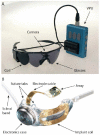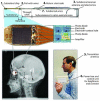Retinal prosthesis
- PMID: 24710817
- PMCID: PMC4356127
- DOI: 10.1109/TBME.2014.2314733
Retinal prosthesis
Abstract
Retinal prosthesis has been translated from the laboratory to the clinic over the past two decades. Currently, two devices have regulatory approval for the treatment of retinitis pigmentosa. These devices provide partial sight restoration and patients use this improved vision in their everyday lives. Improved mobility and object detection are some of the more notable findings from the clinical trials. However, significant vision restoration will require both better technology and improved understanding of the interaction between electrical stimulation and the retina. This paper reviews the recent clinical trials and highlights technology breakthroughs that will contribute to next generation of retinal prostheses.
Figures









References
-
- Dowling JE. The Retina: an approachable part of the Brain. Bellknap Press; 1987.
-
- Hartong DT, Berson EL, Dryja TP. Retinitis Pigmentosa. Lancet. 2006 Nov;368:1795–1809. - PubMed
-
- Potts AM, Inoue J. The electrically evoked response (EER) of the visual system. II. Effect of adaptation and retinitis pigmentosa. Invest. Ophth. 1969 Jun;8(6):605–12. - PubMed
Publication types
MeSH terms
Grants and funding
LinkOut - more resources
Full Text Sources
Other Literature Sources
Miscellaneous

